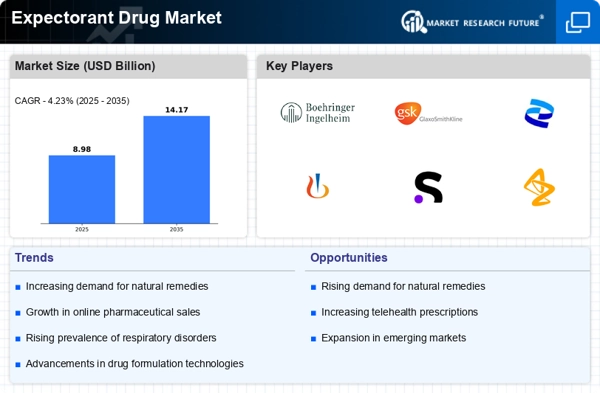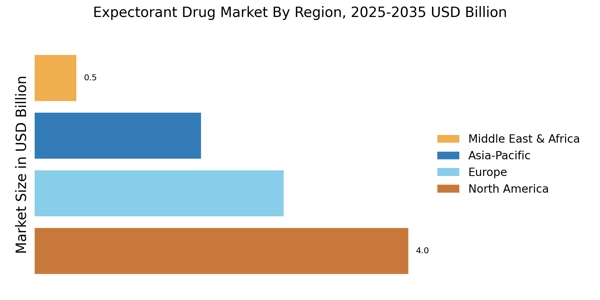Increasing Awareness of Respiratory Health
The growing awareness of respiratory health and the importance of maintaining optimal lung function appear to be significant factors driving the Expectorant Drug Market. Public health campaigns and educational initiatives are emphasizing the need for effective management of respiratory conditions, which may lead to increased consumption of expectorant medications. Data suggests that as individuals become more informed about the benefits of expectorants in alleviating symptoms of cough and congestion, the market is likely to see a surge in demand. Additionally, healthcare professionals are increasingly recommending expectorants as part of comprehensive treatment plans, further solidifying their role in respiratory health management. This heightened awareness could potentially translate into sustained growth for the expectorant drug sector.
Growing Prevalence of Respiratory Disorders
The rising incidence of respiratory disorders, such as asthma and chronic obstructive pulmonary disease (COPD), appears to be a primary driver for the Expectorant Drug Market. According to recent data, respiratory diseases account for a substantial portion of global health issues, leading to increased demand for effective treatments. The World Health Organization indicates that millions of individuals are affected by these conditions, necessitating the use of expectorants to alleviate symptoms. This trend suggests that as the population ages and environmental factors contribute to respiratory ailments, the market for expectorant drugs is likely to expand significantly. Furthermore, the growing awareness of respiratory health and the importance of managing these conditions effectively may further bolster the market's growth in the coming years.
Expansion of E-commerce and Online Pharmacies
The expansion of e-commerce and the rise of online pharmacies are transforming the landscape of the Expectorant Drug Market. Consumers are increasingly turning to online platforms for purchasing medications, including expectorants, due to the convenience and accessibility they offer. Market analysis indicates that the online pharmacy segment is experiencing rapid growth, driven by the increasing adoption of digital technologies and changing consumer behaviors. This trend suggests that as more individuals seek to purchase expectorants online, the market will likely benefit from enhanced distribution channels and broader reach. Furthermore, the competitive pricing and promotional offers available through e-commerce platforms may further stimulate demand for expectorant drugs, contributing to the overall growth of the industry.
Advancements in Pharmaceutical Research and Development
Innovations in pharmaceutical research and development are playing a crucial role in shaping the Expectorant Drug Market. The emergence of novel drug formulations and delivery systems is enhancing the efficacy and safety profiles of expectorants. Recent advancements, such as the development of combination therapies that include expectorants, are gaining traction among healthcare providers. This evolution in drug development is likely to attract more investment and interest from pharmaceutical companies, potentially leading to a wider array of products available in the market. Furthermore, the increasing focus on personalized medicine may also drive the demand for tailored expectorant therapies, thereby expanding the market's scope and appeal to diverse patient populations.
Rising Consumer Preference for Over-the-Counter Medications
The shift towards self-medication and the increasing preference for over-the-counter (OTC) medications are likely to influence the Expectorant Drug Market positively. Consumers are becoming more proactive in managing their health, often opting for readily available OTC expectorants to treat mild respiratory symptoms. Market data indicates that the OTC segment is experiencing robust growth, driven by the convenience and accessibility of these products. This trend suggests that as more individuals seek immediate relief from cough and congestion, the demand for expectorant drugs will continue to rise. Additionally, the marketing strategies employed by pharmaceutical companies to promote these products may further enhance consumer awareness and drive sales in the expectorant drug sector.


















Leave a Comment